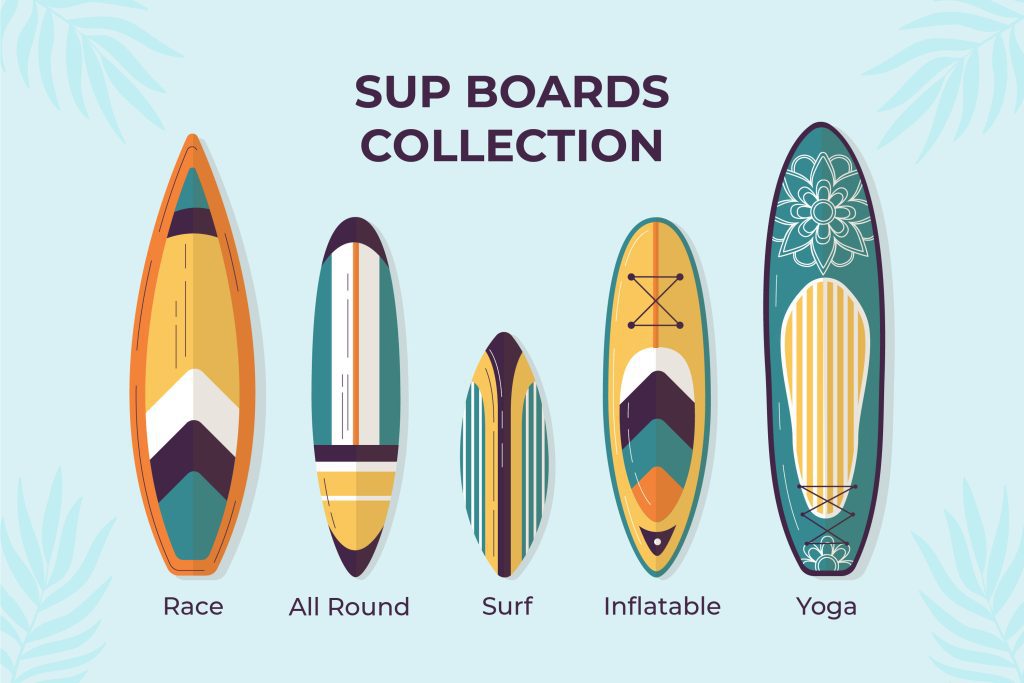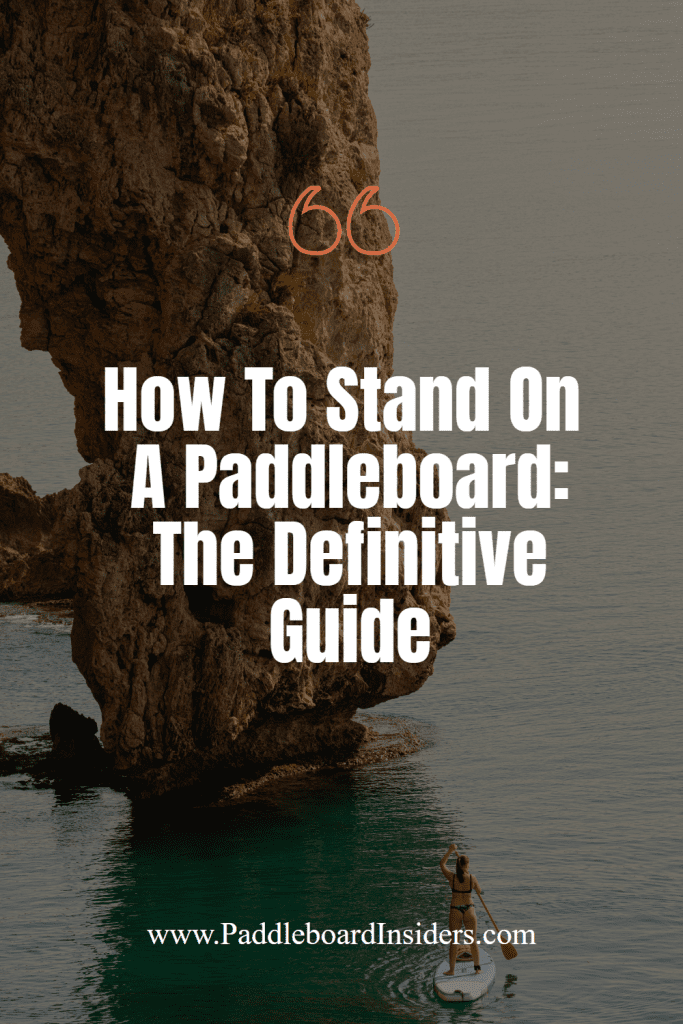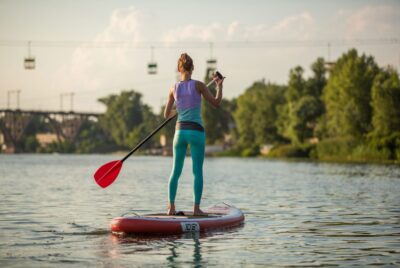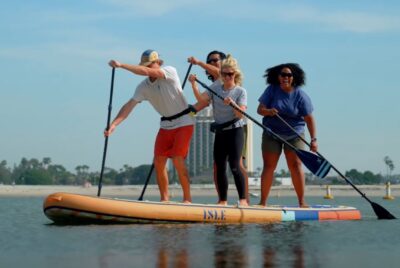How To Stand On A Paddleboard: Get Up In Five Minutes Or Less
*We may earn a commission for purchases made using our links. Please see our disclosure to learn more.
If you’re curious about stand up paddleboarding or have recently taken an interest in this fantastic water activity, then you’ve come to the right place. As an avid stand up paddleboarder, I’m here to show you step-by-step how to stand on a paddleboard with confidence and ease. So, let’s dive in and explore the exciting world of stand up paddleboarding!
| Looking for our best paddle board product recommendations? Check the Paddleboard Insiders Buyer Guides |
Table Of Contents
- The Basics – How To Stand On A Paddleboard In 5 Minutes Or Less:
- The Board – How To Stand Up On A Paddleboard:
- Essential Equipment for Stand Up Paddleboarding:
- The Key Benefits of Stand Up Paddleboarding:
- Our Best Safety Tips and Precautions
- Exploring Different Types of Stand Up Paddleboarding:
- Conclusion: How To Stand On A Paddleboard
- FAQs:
The Basics – How To Stand On A Paddleboard In 5 Minutes Or Less:
Now that you have your equipment ready, it’s time to learn the fundamental techniques for standing on a paddleboard. Follow these steps to get started:
Here is a great video example of how to stand up on a paddleboard in the next 5 minutes (for those of you that learn better with a visual guide):
Finding Your Balance: Begin by kneeling on the board, with your knees shoulder-width apart. Slowly shift your weight forward and find your center of balance. Keep your gaze ahead, not down at your feet.
Proper Stance and Foot Placement: From a kneeling position, transition to standing up one foot at a time. Place your feet parallel, hip-width apart, with toes pointing forward. Maintain a slight bend in your knees for stability.
Engaging Your Core Muscles: Your core muscles play a vital role in maintaining stability on a paddleboard. Keep your abdominal muscles engaged and your back straight. This will help you maintain balance and prevent unnecessary strain on your lower back.
Paddle Technique: Hold the paddle with one hand on the handle and the other hand on the shaft, slightly wider than shoulder-width apart. Dip the paddle blade into the water and pull it back, using your core muscles to generate power. Alternate sides with each stroke.
Getting On And Off The Stand Up Paddleboard:
Entering and exiting the water with your paddleboard requires some technique to ensure a smooth experience. Let’s go through the steps:
Entering the Water: Find a suitable entry point with calm water. Hold your paddle securely with one hand and walk into the water until it’s deep enough to float your board without touching the fins.
Mounting the Board: With one hand on the paddle and the other on the board’s rail, position the board parallel to the shoreline. Place your paddle across the board horizontally. From a kneeling position, carefully step onto the board, one foot at a time, maintaining balance as you rise.
Dismounting the Board: To exit the water, paddle towards the shore in shallow water. Find a stable spot to disembark, such as a sandy beach or a dock. From a standing position, lower yourself to a kneeling position, and then step off the board onto the stable surface.
Maintaining Stability and Control:
To ensure a smooth and enjoyable paddleboarding experience, it’s important to maintain stability and control while on the water. Here are a few tips to help you:
Maintaining a Steady Rhythm: Establish a comfortable and steady paddling rhythm to maintain stability. Avoid sudden and jerky movements that may throw off your balance.
Adjusting Your Stance: As you encounter different water conditions, adjust your stance accordingly. For choppy waters, bend your knees slightly and widen your stance to absorb the impact. In calmer waters, you can stand with a straighter posture.
Using Your Paddle for Balance: Your paddle can act as a stabilizing tool. Place the blade of your paddle into the water and use it as a brace for balance when needed. This technique is particularly useful when encountering waves or maintaining stability in windy conditions.
It’s extremely important that you know what to do when you inevitably fall of your paddleboard into the water, but the good news is that this doesn’t need to be a big deal.
Here is a great reference video that will help you clim back onto your SUP without all the struggle:
Advanced Techniques and Tips:
Once you’ve mastered the basics, you can explore advanced techniques and tips to elevate your paddleboarding skills. Here are a few suggestions:
Turning and Maneuvering: To turn your paddleboard, use small and controlled paddle strokes on the side opposite to your desired direction. For sharper turns, drag the paddle behind you while using your body weight to pivot the board.
Dealing with Wind and Waves: Paddling against the wind can be challenging. To overcome this, paddle on one side more than the other, using a sweeping motion to keep the board straight. When encountering waves, approach them at a slight angle to avoid getting knocked off balance.
Paddling Techniques for Different Conditions: Adapt your paddling technique based on the water conditions. In calm waters, focus on long and efficient strokes. In choppy waters, use shorter and more rapid strokes to maintain balance and control.
The Board – How To Stand Up On A Paddleboard:
Before you can start standing on a paddleboard, it’s essential to choose the right one that suits your needs and abilities. Here are a few factors to consider:
Board Type and Size: There are different types of stand up paddleboards, including all-around, touring, and surfing boards. The size of the board also matters, as it affects stability and maneuverability. Beginners generally benefit from wider and longer boards for increased stability.

Materials and Construction: Stand up paddleboards are constructed from various materials, such as fiberglass, foam, and inflatable options. Each material has its pros and cons in terms of durability, weight, and performance. Consider your preferences and budget when selecting the right construction for your paddleboard.
Stability and Maneuverability: Stability is crucial, especially for beginners. Look for paddleboards with wider widths and a larger volume to ensure better stability. Maneuverability becomes more important as you progress, so consider a narrower board for increased responsiveness.
PRO TIP: If you are a beginner that is just learning to stand then I recommend using an inflatable SUP board, because it will give you a great blend of stability and manouverability to give you the best chances of getting up fast.
Essential Equipment for Stand Up Paddleboarding:
Now that you have your paddleboard, it’s time to gather the essential equipment that ensures a safe and enjoyable experience on the water. Here’s what you’ll need:
Paddle Selection:
Choose a paddle that suits your height and paddling style. Adjustable paddles are versatile and allow you to customize the length based on your preferences. Additionally, consider the material and weight of the paddle for optimal comfort during long paddling sessions.

Where To Buy: Amazon
Why I Love It:
– Can be broken down into 4 pieces so its easy to transport.
– Ergonomic T-type handle that is non-slippery and easy on the hands.
– ABS locking system means that it will be secure and you can adjust it to match your size.
– High quality paddle that will last you forever.
Personal Flotation Device (PFD):
Safety should always be a priority when engaging in water activities. Wearing a PFD is crucial, especially if you’re paddleboarding in open water or unfamiliar locations. Ensure your PFD is Coast Guard-approved and fits properly for maximum safety.
Where To Buy: Amazon
Why I Love It:
– Designed so that it doesn’t obstruct your paddling because it leaves the shoulders open
– Highly visible so that you can be seen by other watercraft even in low light conditions
– Heavy duty and will keep even the heaviest people afloat.
– Also includes a whistle for extra safety

Safety Leash:
A safety leash keeps you connected to your paddleboard, preventing it from drifting away if you fall into the water. Choose a leash that’s appropriate for the conditions and your paddleboarding style. For calm waters, a straight leash works well, while coiled leashes are ideal for rougher conditions.

Where To Buy: Amazon
Why I Love It:
– Made of ultra-strong urethane cord that can handle the heaviest and longest boards
– Got soft sponge that doesn’t hurt you when you paddle
– Includes a waterproof wallet for your phone and keys
– They have great support so that you can ask questions and get a return if something breaks
Clothing and Sun Protection:
Dress appropriately for your paddleboarding adventure. Opt for comfortable and quick-drying attire, such as board shorts or a swimsuit. Apply waterproof sunscreen to protect your skin from harmful UV rays and wear a hat and sunglasses for added sun protection.
Where To Buy: Amazon
Why I Love It:
– Water resistant and high SPF so you can be in and out of the water without worrying about getting burnt.
– It mosturizes the skin and is also non-stick so sand won’t be stuck to you.
– Smells great

My Favorite Paddleboards Of 2025:
* Roc Inflatable SUP (Best Budget SUP OF 2025)

Where To Buy: Amazon
Why I Love It:
– Has a large non-slip comfort deck that can easily fit you and even an extra person
– Extremely high quality material that won’t get scuffed and damaged.
– 16.25 inch width makes it very stable
– It looks great!
* Portal 11’6″ Paddle Board (Best Overall SUP)
Where To Buy: Amazon
Why I Love It:
– 33 inch width gives it amazing width and stability.
– It has a depth of 6 inches that increases the weight capacity of the board to over 300lbs without sacrificing stability.
– This board has ample space along with a non-slip deck pad that is perfect for beginners
– It comes with everything included and a 2 year warranty.

* MYBOAT 11’6″Extra Wide SUP (Best Full Length Deck)

Where To Buy: Amazon
Why I Love It:
– This board is extra long and extra wide which is ideal for beginners (because it’s super stable)
– This board was designed for yoga so it’s super stable
– It comes with everything included and a 1 year warranty.
The Key Benefits of Stand Up Paddleboarding:
Stand up paddleboarding offers a myriad of incredible health benefits that go beyond just having fun on the water. It’s a wonderful way to engage in physical activity while enjoying the beauty of nature. Let’s take a look at some of the advantages:
Physical Fitness: Stand up paddleboarding is a full-body workout that engages your core, arms, legs, and back muscles. By simply balancing on the board and propelling yourself forward with a paddle, you’ll be toning your muscles and improving your overall strength and endurance.
Mental Well-being: Being out on the water, surrounded by tranquility, can have a positive impact on your mental well-being. Stand up paddleboarding allows you to disconnect from the daily hustle and bustle, providing a sense of calm and serenity.
Low Impact Exercise: Unlike high-impact activities, such as running or jumping, stand up paddleboarding is gentle on your joints. It’s a low-impact exercise that reduces the risk of injury while still providing an excellent cardiovascular workout.
And on top of that – it’s one of the best ways to explore the world that I have ever seen.
Picture this – you can travel anywhere and see the landscape from a different angle. Paddle through the beaches of Northern Oregon. Explore the best places to visit in Montenegro. And even take a tour of Mykonos if your heart pulls you that direction.
It’s all possible with a paddle board – you can see the world through a different lens, and there’s something just so magical about this.
Our Best Safety Tips and Precautions
Safety should always be a top priority when engaging in any water activity. Here are some important tips and precautions to ensure a safe paddleboarding experience:
Checking Weather and Water Conditions: Before heading out, check the weather forecast and water conditions. Avoid paddleboarding in strong winds, thunderstorms, or rough waters that exceed your skill level.
Importance of Wearing a Leash: Always wear a leash that attaches you to your paddleboard. In case of a fall, the leash will prevent your board from drifting away, making it easier to retrieve and remount.
Learning Basic Self-Rescue Techniques: Familiarize yourself with basic self-rescue techniques, such as climbing back onto your board from the water or paddling on your stomach if you’re fatigued. These skills can be invaluable in case of unexpected challenges.
Avoiding Overexertion and Heat Exhaustion: Paddleboarding can be physically demanding, especially in hot weather. Stay hydrated, take breaks when needed, and avoid overexertion to prevent heat exhaustion or dehydration.
Exploring Different Types of Stand Up Paddleboarding:
Stand up paddleboarding offers diverse options for exploration and enjoyment. Let’s take a look at some popular types:
Touring and Recreation: Explore scenic waterways, lakes, and coastlines at your own pace. Touring paddleboards are designed for stability and efficiency, making them perfect for longer trips and sightseeing.
SUP Yoga and Fitness: Combine the tranquility of yoga with the challenge of balancing on a paddleboard. SUP yoga and fitness classes provide a unique and engaging workout while connecting with nature.
Paddleboard Surfing: Experience the thrill of catching waves on a stand up paddleboard. Surfing combines the skills of traditional surfing with the added stability and paddle power of a paddleboard.
SUP Racing: Test your skills and compete in SUP racing events. Races vary in distance and difficulty, providing opportunities for both recreational and competitive paddleboarders.
Conclusion: How To Stand On A Paddleboard
Congratulations! You’re now equipped with the knowledge and tips on how to stand up on a paddleboard. Remember to choose the right board, gather essential equipment, and practice the fundamental techniques. With time and experience, you’ll become a skilled paddleboarder, exploring various types of paddleboarding and enjoying the numerous physical and mental benefits it offers.
| Looking for insider guides to some amazing paddle boarding locations? Check the Paddleboard Insiders Location Guides |
FAQs:
Can anyone learn how to stand up on a paddleboard?
Absolutely! Stand up paddleboarding is suitable for people of all ages and fitness levels. It’s a versatile activity that can be adapted to your individual abilities.
Do I need prior experience to try stand up paddleboarding?
No prior experience is necessary to start paddleboarding. Beginners can take lessons or learn from experienced paddlers to acquire the necessary skills and knowledge.
How long does it take to become proficient at stand up paddleboarding?
The learning curve varies from person to person. With regular practice and dedication, you can become proficient within a few weeks or months. Patience and persistence are key.
Can I paddleboard alone, or should I always have a partner?
Paddleboarding alone is possible but having a partner or paddling in a group is generally recommended for safety reasons. It’s more fun to share the experience with others as well. If you’re learning how to stand on a paddleboard I would advise going with someone else in the beginning.
Are there any age restrictions for stand up paddleboarding?
There are no strict age restrictions, but children should be accompanied by adults or receive appropriate supervision. Always prioritize safety when involving children in water activities.





